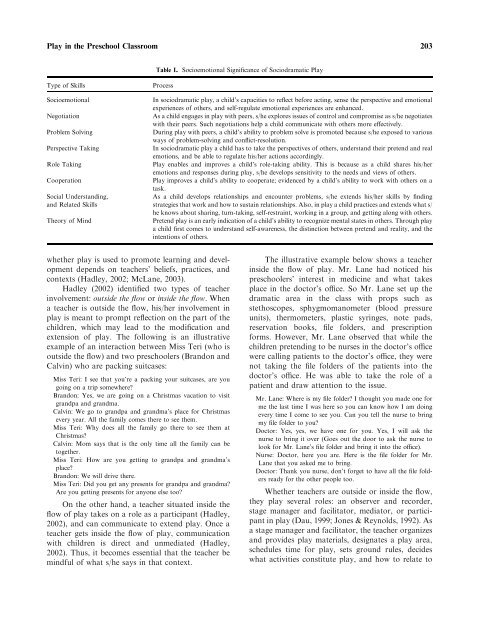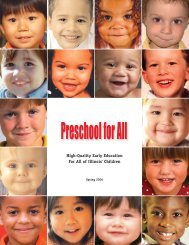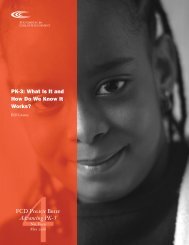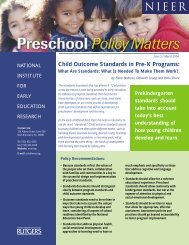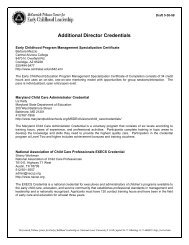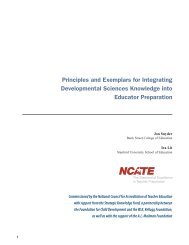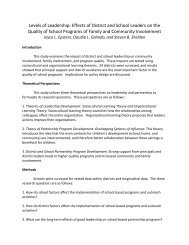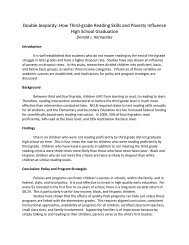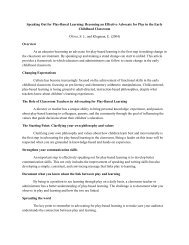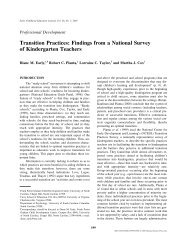Play in the Preschool Classroom - Leadership to INtegrate the Early ...
Play in the Preschool Classroom - Leadership to INtegrate the Early ...
Play in the Preschool Classroom - Leadership to INtegrate the Early ...
Create successful ePaper yourself
Turn your PDF publications into a flip-book with our unique Google optimized e-Paper software.
<strong>Play</strong> <strong>in</strong> <strong>the</strong> <strong>Preschool</strong> <strong>Classroom</strong><br />
203<br />
Table I. Socioemotional Significance of Sociodramatic <strong>Play</strong><br />
Type of Skills<br />
Socioemotional<br />
Negotiation<br />
Problem Solv<strong>in</strong>g<br />
Perspective Tak<strong>in</strong>g<br />
Role Tak<strong>in</strong>g<br />
Cooperation<br />
Social Understand<strong>in</strong>g,<br />
and Related Skills<br />
Theory of M<strong>in</strong>d<br />
Process<br />
In sociodramatic play, a child’s capacities <strong>to</strong> reflect before act<strong>in</strong>g, sense <strong>the</strong> perspective and emotional<br />
experiences of o<strong>the</strong>rs, and self-regulate emotional experiences are enhanced.<br />
As a child engages <strong>in</strong> play with peers, s/he explores issues of control and compromise as s/he negotiates<br />
with <strong>the</strong>ir peers. Such negotiations help a child communicate with o<strong>the</strong>rs more effectively.<br />
Dur<strong>in</strong>g play with peers, a child’s ability <strong>to</strong> problem solve is promoted because s/he exposed <strong>to</strong> various<br />
ways of problem-solv<strong>in</strong>g and conflict-resolution.<br />
In sociodramatic play a child has <strong>to</strong> take <strong>the</strong> perspectives of o<strong>the</strong>rs, understand <strong>the</strong>ir pretend and real<br />
emotions, and be able <strong>to</strong> regulate his/her actions accord<strong>in</strong>gly.<br />
<strong>Play</strong> enables and improves a child’s role-tak<strong>in</strong>g ability. This is because as a child shares his/her<br />
emotions and responses dur<strong>in</strong>g play, s/he develops sensitivity <strong>to</strong> <strong>the</strong> needs and views of o<strong>the</strong>rs.<br />
<strong>Play</strong> improves a child’s ability <strong>to</strong> cooperate; evidenced by a child’s ability <strong>to</strong> work with o<strong>the</strong>rs on a<br />
task.<br />
As a child develops relationships and encounter problems, s/he extends his/her skills by f<strong>in</strong>d<strong>in</strong>g<br />
strategies that work and how <strong>to</strong> susta<strong>in</strong> relationships. Also, <strong>in</strong> play a child practices and extends what s/<br />
he knows about shar<strong>in</strong>g, turn-tak<strong>in</strong>g, self-restra<strong>in</strong>t, work<strong>in</strong>g <strong>in</strong> a group, and gett<strong>in</strong>g along with o<strong>the</strong>rs.<br />
Pretend play is an early <strong>in</strong>dication of a child’s ability <strong>to</strong> recognize mental states <strong>in</strong> o<strong>the</strong>rs. Through play<br />
a child first comes <strong>to</strong> understand self-awareness, <strong>the</strong> dist<strong>in</strong>ction between pretend and reality, and <strong>the</strong><br />
<strong>in</strong>tentions of o<strong>the</strong>rs.<br />
whe<strong>the</strong>r play is used <strong>to</strong> promote learn<strong>in</strong>g and development<br />
depends on teachers’ beliefs, practices, and<br />
contexts (Hadley, 2002; McLane, 2003).<br />
Hadley (2002) identified two types of teacher<br />
<strong>in</strong>volvement: outside <strong>the</strong> flow or <strong>in</strong>side <strong>the</strong> flow. When<br />
a teacher is outside <strong>the</strong> flow, his/her <strong>in</strong>volvement <strong>in</strong><br />
play is meant <strong>to</strong> prompt reflection on <strong>the</strong> part of <strong>the</strong><br />
children, which may lead <strong>to</strong> <strong>the</strong> modification and<br />
extension of play. The follow<strong>in</strong>g is an illustrative<br />
example of an <strong>in</strong>teraction between Miss Teri (who is<br />
outside <strong>the</strong> flow) and two preschoolers (Brandon and<br />
Calv<strong>in</strong>) who are pack<strong>in</strong>g suitcases:<br />
Miss Teri: I see that you’re a pack<strong>in</strong>g your suitcases, are you<br />
go<strong>in</strong>g on a trip somewhere?<br />
Brandon: Yes, we are go<strong>in</strong>g on a Christmas vacation <strong>to</strong> visit<br />
grandpa and grandma.<br />
Calv<strong>in</strong>: We go <strong>to</strong> grandpa and grandma’s place for Christmas<br />
every year. All <strong>the</strong> family comes <strong>the</strong>re <strong>to</strong> see <strong>the</strong>m.<br />
Miss Teri: Why does all <strong>the</strong> family go <strong>the</strong>re <strong>to</strong> see <strong>the</strong>m at<br />
Christmas?<br />
Calv<strong>in</strong>: Mom says that is <strong>the</strong> only time all <strong>the</strong> family can be<br />
<strong>to</strong>ge<strong>the</strong>r.<br />
Miss Teri: How are you gett<strong>in</strong>g <strong>to</strong> grandpa and grandma’s<br />
place?<br />
Brandon: We will drive <strong>the</strong>re.<br />
Miss Teri: Did you get any presents for grandpa and grandma?<br />
Are you gett<strong>in</strong>g presents for anyone else <strong>to</strong>o?<br />
On <strong>the</strong> o<strong>the</strong>r hand, a teacher situated <strong>in</strong>side <strong>the</strong><br />
flow of play takes on a role as a participant (Hadley,<br />
2002), and can communicate <strong>to</strong> extend play. Once a<br />
teacher gets <strong>in</strong>side <strong>the</strong> flow of play, communication<br />
with children is direct and unmediated (Hadley,<br />
2002). Thus, it becomes essential that <strong>the</strong> teacher be<br />
m<strong>in</strong>dful of what s/he says <strong>in</strong> that context.<br />
The illustrative example below shows a teacher<br />
<strong>in</strong>side <strong>the</strong> flow of play. Mr. Lane had noticed his<br />
preschoolers’ <strong>in</strong>terest <strong>in</strong> medic<strong>in</strong>e and what takes<br />
place <strong>in</strong> <strong>the</strong> doc<strong>to</strong>r’s office. So Mr. Lane set up <strong>the</strong><br />
dramatic area <strong>in</strong> <strong>the</strong> class with props such as<br />
stethoscopes, sphygmomanometer (blood pressure<br />
units), <strong>the</strong>rmometers, plastic syr<strong>in</strong>ges, note pads,<br />
reservation books, file folders, and prescription<br />
forms. However, Mr. Lane observed that while <strong>the</strong><br />
children pretend<strong>in</strong>g <strong>to</strong> be nurses <strong>in</strong> <strong>the</strong> doc<strong>to</strong>r’s office<br />
were call<strong>in</strong>g patients <strong>to</strong> <strong>the</strong> doc<strong>to</strong>r’s office, <strong>the</strong>y were<br />
not tak<strong>in</strong>g <strong>the</strong> file folders of <strong>the</strong> patients <strong>in</strong><strong>to</strong> <strong>the</strong><br />
doc<strong>to</strong>r’s office. He was able <strong>to</strong> take <strong>the</strong> role of a<br />
patient and draw attention <strong>to</strong> <strong>the</strong> issue.<br />
Mr. Lane: Where is my file folder? I thought you made one for<br />
me <strong>the</strong> last time I was here so you can know how I am do<strong>in</strong>g<br />
every time I come <strong>to</strong> see you. Can you tell <strong>the</strong> nurse <strong>to</strong> br<strong>in</strong>g<br />
my file folder <strong>to</strong> you?<br />
Doc<strong>to</strong>r: Yes, yes, we have one for you. Yes, I will ask <strong>the</strong><br />
nurse <strong>to</strong> br<strong>in</strong>g it over (Goes out <strong>the</strong> door <strong>to</strong> ask <strong>the</strong> nurse <strong>to</strong><br />
look for Mr. Lane’s file folder and br<strong>in</strong>g it <strong>in</strong><strong>to</strong> <strong>the</strong> office).<br />
Nurse: Doc<strong>to</strong>r, here you are. Here is <strong>the</strong> file folder for Mr.<br />
Lane that you asked me <strong>to</strong> br<strong>in</strong>g.<br />
Doc<strong>to</strong>r: Thank you nurse, don’t forget <strong>to</strong> have all <strong>the</strong> file folders<br />
ready for <strong>the</strong> o<strong>the</strong>r people <strong>to</strong>o.<br />
Whe<strong>the</strong>r teachers are outside or <strong>in</strong>side <strong>the</strong> flow,<br />
<strong>the</strong>y play several roles: an observer and recorder,<br />
stage manager and facilita<strong>to</strong>r, media<strong>to</strong>r, or participant<br />
<strong>in</strong> play (Dau, 1999; Jones & Reynolds, 1992). As<br />
a stage manager and facilita<strong>to</strong>r, <strong>the</strong> teacher organizes<br />
and provides play materials, designates a play area,<br />
schedules time for play, sets ground rules, decides<br />
what activities constitute play, and how <strong>to</strong> relate <strong>to</strong>


